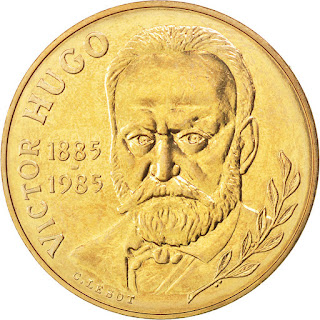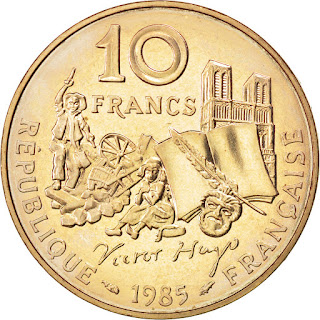French Coins 10 Francs 1985 Victor Hugo
Commemorative issue: 100th Anniversary of the Death of Victor Hugo
Obverse: in the coin centre bust of Victor Hugo en face; on the left in three lines: 1885 - 1985; along the left edge: VICTOR HUGO; along the right edge a laurel branch
edge: plain with concave inscription: LIBERTÉ ÉGALITÉ FRATERNITÉ (motto of France - liberty, equality, fraternity) divided by olive branch, laurel branch and cereal ear
NOTE: Rim types "Tranche A" and "Tranche B".
Lettering: VICTOR HUGO 1885 1985 C.LESOT.
Engraver: Claude Lesot.
Reverse: on top of the coin in two lines face value: 10 FRANCS; in coin centre scene from the novel "Les Miserables" Cosette and Gavroche at the barricade; next to it there is a manustript, a quill and a mask; below signature of Victor Hugo; along the bottom edge: RÉPUBLIQUE FRANÇAISE (French Republic) divided by year of issue 1985.
Lettering: 10 FRANCS Victor Hugo RÉPUBLIQUE 1985 FRANÇAISE.
Engraver: Claude Lesot.
Edge: Smooth with inscription.
Lettering: LIBERTE EGALITE FRATERNITE.
Face value: 10 Francs.
Metal: Copper-nickel Aluminium.
Weight: 10 g.
Diameter: 26 mm.
Thickness: 2.5 mm.
Shape: Round.
Designer: Claude Lesot (signature G.LESOT along the bottom edge of the obverse)
Mint: Paris Mint mark La Monnaie de Paris (The Paris Mint), Pessac (mint mark before year of issue 1985 in the obverse, after year of issue privy mark of mint's director Émile Rousseau - dolphin).
Mintage: 9 988 011 + 12 500 in annual boxed sets.
Victor Hugo
Victor Marie Hugo (26 February 1802 – 22 May 1885) was a French poet, novelist, and dramatist of the Romantic movement. He is considered one of the greatest and best-known French writers. In France, Hugo's literary fame comes first from his poetry and then from his novels and his dramatic achievements. Among many volumes of poetry, Les Contemplations and La Légende des siècles stand particularly high in critical esteem. Outside France, his best-known works are the novels Les Misérables, 1862, and Notre-Dame de Paris, 1831 (known in English as The Hunchback of Notre-Dame). He also produced more than 4,000 drawings, which have since been admired for their beauty, and earned widespread respect as a campaigner for social causes such as the abolition of capital punishment.
Though a committed royalist when he was young, Hugo's views changed as the decades passed, and he became a passionate supporter of republicanism; his work touches upon most of the political and social issues and the artistic trends of his time. He is buried in the Panthéon. His legacy has been honoured in many ways, including his portrait being placed on francs.
Les Misérables
Les Misérables is a French historical novel by Victor Hugo, first published in 1862, that is considered one of the greatest novels of the 19th century. In the English-speaking world, the novel is usually referred to by its original French title. However, several alternatives have been used, including The Miserable, The Wretched, The Miserable Ones, The Poor Ones, The Wretched Poor, The Victims and The Dispossessed. Beginning in 1815 and culminating in the 1832 June Rebellion in Paris, the novel follows the lives and interactions of several characters, particularly the struggles of ex-convict Jean Valjean and his experience of redemption.
Examining the nature of law and grace, the novel elaborates upon the history of France, the architecture and urban design of Paris, politics, moral philosophy, antimonarchism, justice, religion, and the types and nature of romantic and familial love. Les Misérables has been popularized through numerous adaptations for the stage, television, and film, including a musical and a film adaptation of that musical.
The appearance of the novel was highly anticipated and advertised. Critical reactions were diverse, but most of them were negative. Commercially, the work was a great success globally.

